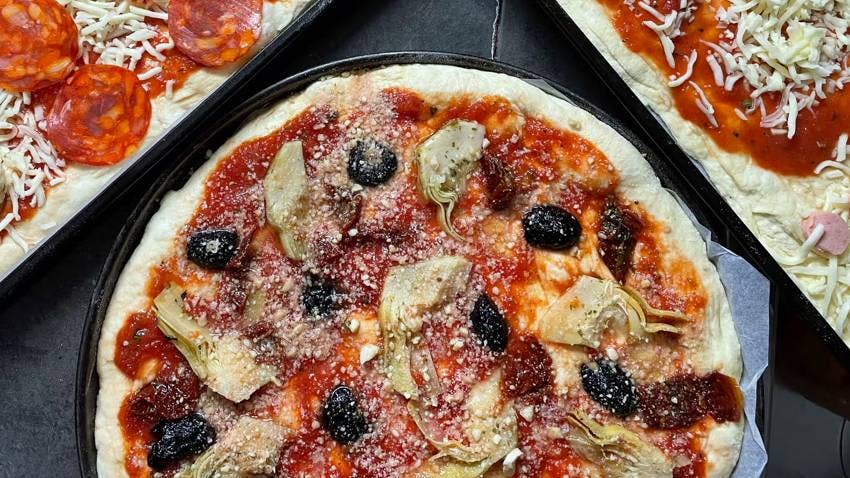

The pizza, symbol of Italy worldwide, is much more than just a dish: it's culture, tradition, and passion all rolled into one. With its leavened dough base, topped with tomato sauce and mozzarella, pizza embodies the essence of Italian cuisine and has won over the taste buds of millions worldwide. But behind this beloved dish lies a fascinating history and a wide array of variations that reflect the cultural diversity of Italian regions and the international taste for gastronomic innovation.
A bit of history
Pizza's history traces back to antiquity, when ancient Greeks and Romans prepared similar flatbread dishes topped with olive oil, herbs, and cheese.
It wasn't until the 18th century in Naples that pizza began to take the form we know today. Initially considered a food for the poor, pizza soon became popular among all social classes, including the wealthiest. In fact, the name of the most classic and well-known pizza, the one with tomato and mozzarella, has a royal origin. In 1889, pizzaiolo Raffaele Esposito created the "Margherita" pizza in honor of Queen Margherita of Savoy's visit to Naples: the pizza was topped with tomato, mozzarella, and basil, whose colors—red, white, and green—mirrored those of the Italian flag.
The pizza conquers the world
Since then, the Margherita pizza has become a symbol of Italy and an iconic dish appreciated worldwide: from a local phenomenon, pizzerias have spread from Southern to Northern Italy and abroad, also thanks to Italian migrants who brought a taste of their culinary traditions to new continents.
In 2017, the art of the Neapolitan pizzaiolo was declared by UNESCO as intangible cultural heritage of humanity.
The recipe of Margherita pizza
After talking so much about pizza, perhaps you feel like trying your hand at baking a fragrant pizza comfortably at home. Below, we offer you the recipe from our Cesarina Emanuela to prepare a tasty Margherita pizza.

Pizza Margherita
A simple recipe to bake a pizza that won't make you miss the pizzeria's
Ingredients
- For the dough:
- 1 kg of type 00 flour
- 40/50 g of fine salt
- 500 ml of lukewarm water
- 1 g of yeast
- For the topping:
- 1 rustic tomato sauce
- 400 g of mozzarella fior di latte from Agerola
- Extra virgin olive oil
- Basil
- Grated Parmesan or Grana cheese
Method
- Let's start by putting the flour in a container and dissolving the brewer's yeast in water.
- Add the salt to the flour and gradually pour in the water with the yeast.
- Knead by adding 40 g of oil until you get an elastic mixture that doesn't stick to the sides of the bowl.
- Cover the dough and let it rise for at least an hour.
- After that, create dough balls of about 250 g each and place them in a container covered with a lid or plastic wrap. Let them rise for 10-12 hours.
- Sprinkle our work surface with flour and start working the dough balls, one at a time. Work the dough by progressively stretching it with movements starting from the center and using the 'slap' technique, passing it from one hand to the other.
- When the dough is well stretched, add the tomato sauce, the sliced mozzarella fior di latte, basil leaves, and a sprinkle of Parmesan or Grana.
- Bake the pizza in a preheated oven. The temperature should be at least 250°C and cook for a maximum of 8/10 minutes on a stone or a maximum of 10/15 minutes in a tray.
Pizza and pizzas
Well, now that you know how to make a true Margherita pizza, let's continue our pizza story... Or should we say "pizzas"? Yes, because besides the Neapolitan pizza with its soft and fluffy base, considered the most authentic and traditional, there are many others with very different characteristics, so that everyone can find the one that best suits their taste. There's the Roman pizza characterized by a crispy and thin base; the Palermitan one (the "sfincione"), with a thick and soft base with breadcrumbs, onion, caciocavallo cheese, and tomato preserve; then there's the typical Sicilian pizza, a fried calzone with soft dough filled with cheese and desalted anchovies; and still the Genoese, Pisan, Marchigiana pizzas, just to name a few.

There are also international variations, which often make conservative Italians wrinkle their noses. The most vilified is surely the Hawaiian pizza, whose effect on traditional pizza lovers is comparable to that of garlic on vampires. Born in Canada (yes, Hawaii has nothing to do with it) by the Greek cook Sotirios Panopoulos, the unusual combination of cooked ham, pineapple, and mozzarella creates a sweet-savory mix that divides pizza lovers into two sharply opposing factions. This clash will probably never end, as Hawaiian pizza remains popular in many countries. Much to the chagrin of traditionalists.
The United States also gave birth to several pizza variations, such as the New York style pizza, a pizza with a crispy crust but a soft and thin enough dough to be folded in half and eaten 'on the go'; or the Chicago style pizza (deep-dish pizza) with very high edges and baked in a pan.
But the variations don't end there. Japan, for example, has also contributed: in the Land of the Rising Sun, it is common to find Margherita pizzas with locally flavored toppings, such as teriyaki chicken.

In short, pizza, with its rich history and its almost infinite varieties, is and will continue to be one of the most beloved dishes in the world, and its ability to adapt to local traditions is a tangible sign of the unifying power of cuisine, capable of crossing cultures and generations.
The Cesarine experiences dedicated to pizza
Discover the experiences we have prepared for you, all dedicated to pizza: between cooking classes and menus where pizza is the protagonist, you'll be spoiled for choice!